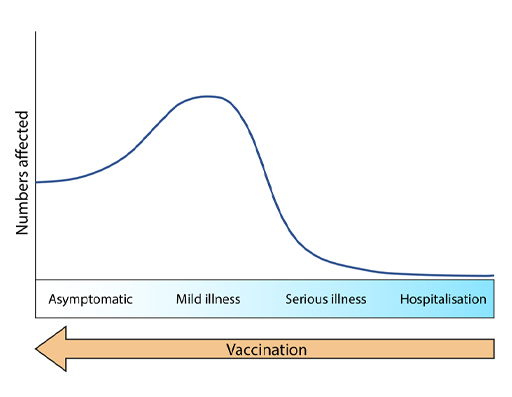1.6 Vaccine effectiveness
Vaccine effectiveness (VE) is defined as the percentage reduction of infection in a group of vaccinated people, compared with a similar unvaccinated group. The two key parameters are the attack rate in the vaccinated group (ARV), compared with the unvaccinated group (ARU).
VE = (ARU – ARV)/ ARU x100%
Activity 1 A phase III vaccine trial
The following activity is based on the data from a phase-3 trial of the Oxford/AstraZeneca AZD1222 vaccine for COVID-19. The trial was randomised, double-blind and all subjects were seronegative for SARS-CoV2 antibodies at the start of the trial.
In this trial 17762 subjects were vaccinated and 8550 received placebo.
73 of the vaccinated group and 130 of the unvaccinated group became infected in the study period.
We now ask you to calculate the vaccine effectiveness using the following steps:
You should first calculate ARV and ARU.
ARV = Number infected / Number vaccinated. ARU = Number infected / Number unvaccinated
Answer
ARV = 73/ 17762 = 0.00411 ARU = 130/ 8550 = 0.0152
Then calculate VE, using the formula:
VE = (ARU – ARV)/ ARU x100%
Click to reveal the answer, once you have made your calculation.
Answer
VE = (ARU – ARV)/ ARU x100% = (0.0152 – 0.0041)/ 0.0152 X100% = 73%
Based on this data the vaccine appears to be effective in reducing the incidence of infection by 73%.
Notice that vaccine effectiveness is normally defined by the attack rate – the reduction in the percentage of infected people. However it is possible to measure ‘effectiveness’ by other means, such as the number of people showing disease symptoms or the number requiring hospitalisation. In the COVID-19 pandemic, the major clinical concerns were the number of people going to hospital, the numbers in intensive care units and the number of deaths.
It was very notable that the COVID-19 vaccines not only reduced incidence of infection, but also reduced hospitalisation and deaths. In effect the spectrum of disease severity, ranging from asymptomatic to hospitalisation was all shifted to the left (Figure 2).

